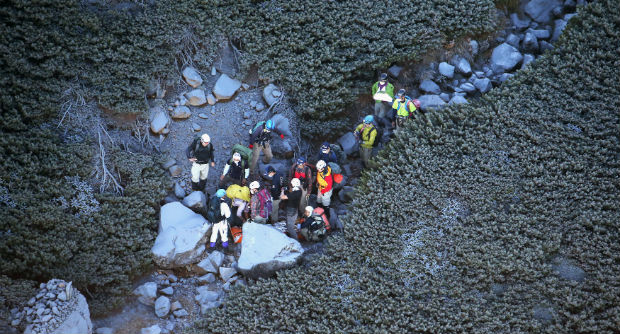
Climbers descend Mount Ontake in central Japan Sunday morning, Sept. 28, 2014, a day after an eruption. Mount Ontake erupted shortly before noon Saturday, spewing large white plumes of gas and ash high into the sky and blanketing the surrounding area in ash. Rescue workers have found 30 or more people unconscious and believed to be dead near the peak of an erupting volcano in central Japan, local government and police said Sunday. AP/Kyodo News
OTAKI – The first deaths were confirmed Sunday among more than 30 hikers feared killed near the peak of a Japanese volcano that erupted without warning, spewing ash, rocks and steam.
Rescue workers battling rocketing levels of sulfurous gas found 31 people in “cardiac arrest” near the summit of 3,067-meter (10,121-foot) Mount Ontake, which erupted around noon on Saturday, police and local officials said.
The term is usually applied before doctors can certify death. Four of those found were brought down the volcano on Sunday where they were confirmed dead, broadcaster NHK reported.
“According to the police, four people out of the 31 people who had been found in cardiac arrest near the peak were confirmed dead. All of them were men,” a station anchorman told viewers.
The news appeared to confirm fears that there was little hope for those still on the volcano.
Rescue efforts were called off mid-afternoon Sunday because the environment was becoming too dangerous for emergency workers, an official at the Nagano prefectural government told AFP.
“The rescue team suspended their operation because of the increasing concentration of sulphurous gas in the area,” the official said.
Firefighters have separately confirmed a total 30 people with injuries, including one serious case, he said, adding that the number could still change.
Some 550 soldiers, police and firefighters took part in a major operation to reach those stranded on the volcano since it erupted into a sunny autumn sky during a busy weekend for tourists and hikers.
A suffocating blanket of ash up to 20 centimeters (eight inches) deep covered a large area of the volcano, and had forced up to 150 to seek refuge in mountaintop shelters at one point.
Local officials believe 45 to 49 people sheltered overnight in cabins on the mountain, although details remained unclear.
The mountain is popular among walkers, particularly in late September when the turning of the autumn leaves makes for dramatic scenery.
On Sunday columns of thick white steam were still rising from Mount Ontake, feathering out into the clear blue sky.
Scenes of horror
Hikers who descended from the volcano reported scenes of horror, with stones raining down and hot ashes filling the air.
Video footage shot inside a cabin, taken shortly after the eruption and shown on NHK, revealed the screams of terrified hikers as rocks thundered against the roof and walls.
Grey, ash-filled air could be seen rolling against the window, thickening into darkness and leaving just the soundtrack of debris pounding on the structure.
A group of 25 hikers – including a schoolchild – who spent the night in a shelter, were able to climb down Sunday to reach the start of one a trail.
A middle-aged man who was among the group said they had been near the summit.
“People panicked,” he told NHK, his face smudged with ashes. “Honestly, I am glad I was able to come back alive.”
Emergency helicopters rescued seven people, including two who were able to wave at a Self Defence Force helicopter.
“Originally, the rescuers thought it might be difficult to go near them because ash could rise (and damage the helicopter), but the conditions were better than they believed and they were able to rescue the two people,” a local official told AFP.
Some 230 hikers were able to make it to safety soon after the eruption.
‘More eruptions forecast’
Television footage showed a line of rescue workers in orange uniforms or green camouflage walking through what looked like a moonscape.
Among the injuries were those caused by flying rocks and internal burns from inhaling volcanic fumes, the Yomiuri Shimbun said.
The meteorological agency forecast further eruptions, warning that volcanic debris may settle within four kilometers (2.5 miles) of the peak.
The agency also restricted access to the mountain, while calling on local residents to remain alert since an eruption could shatter windows miles away.
The last significant eruption of Mount Ontake, which straddles Nagano and Gifu prefectures in the centrerof the country, was in 1979 when it expelled more than 200,000 tonnes of ash,
according to local media.
There were more moderate eruptions in March 2007 and in May 1991.
Japan, which sits at the junction of several of the Earth’s tectonic plates, is dotted with active volcanoes.
Worldwide, the explosion of Indonesia’s Krakatoa volcano in 1883, which killed more than 36,000 people, is considered the worst in modern history.
More recently, Mount Pinatubo in the Philippines killed more than 800 people when it erupted in 1991.
Indonesia’s Mount Merapi – the country’s most active volcano situated on the densely populated island of Java — has erupted twice in the past 20 years with devastating consequences.
The 1994 eruption left 60 dead with 6,000 forced to evacuate, while in 2010 at least 350 people were killed.